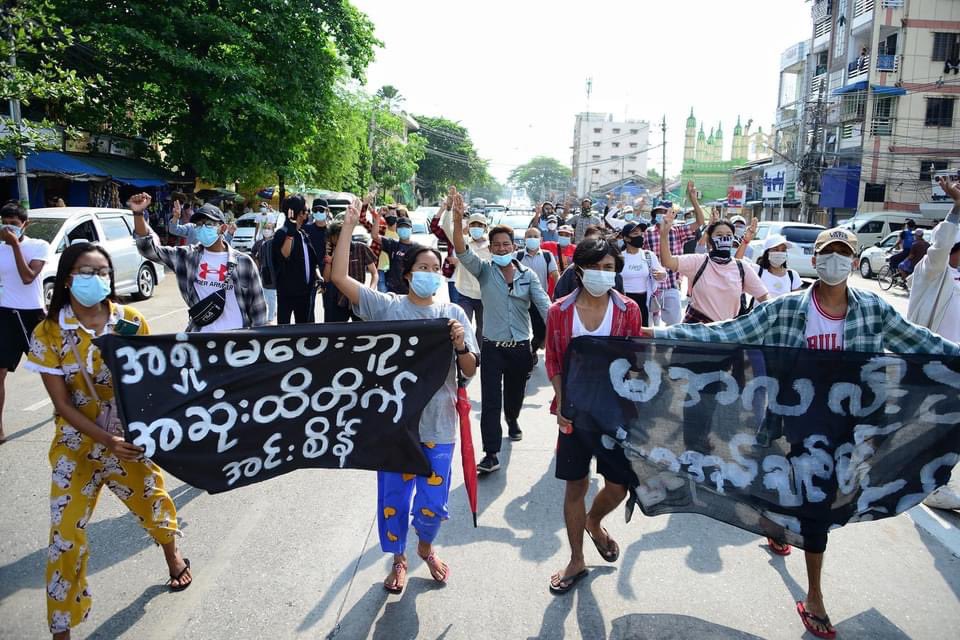
India, Bangladesh and China can help return of democracy to Myanmar
India, China and Bangladesh should not forget the Burmese people and help Myanmar return to being governed under a democratic rule.

The ongoing civil war in Myanmar (formerly Burma) has been under-reported in the Indian media. The continued violence, meanwhile, has had a fall out, which is evident in the northeast of India. There is every indication that the situation will get worse if the hostilities reign on.
Recently, around 60 Burmese pro-democracy fighters crossed over to Mizoram to set up a training camp for Burmese refugees. The Indian government though immediately shut the camps and the activists dispersed to locations unknown.
At the current rate, say local observers, it might not be long before the fleeing pro-democracy activists move to the neighbouring state of Manipur or elsewhere in the northeast. Their primary objective is to secure arms and ammunition. They have already received significant material and media support from international donors and powerful Western lobbies, which strongly back their call for the restoration of democracy. However, given the long record of armed insurgency in the northeast region of India where peace has returned only recently, this is not a prospect that India relishes.
The Tatmadaw (Myanmar Army) is at a distinct advantage, but the opposition NUG (National Unity Government) is no pushover. It is a motley coalition of pro-democracy supporters, entrenched tribal groups and locally powerful tribal armies that have always challenged the military, especially in the bordering areas close to China and India.
China, and to some extent Russia, support the military junta headed by Gen Min Aung Hlaing. The General took over the legislative, judicial and executive powers after dismissing the recently re-elected Aung San Suu Kyi-led National League for Democracy(NLD) in February this year, accusing it of massive corruption.
Apart from the Suu Kyi-led NLD, the NUG’s ranks have increased after soldiers of the Kachin National Army (KNA) and the Arakan Army (AA), rebellious forces have been fighting the Tatmadaw for years, joined in support.
India’s priority is to save the $480 million Kaladan Multimodal River Transport Project (KMMTTP). It needs a finishing touch, in linking Mizoram with Kaletwa (Myanmar. Chin territory) by road in its last phase. The project linking Kolkata by sea to the new Sittwe port in Myanmar was supposed to be completed in 2021, but it has been postponed to 2023, because of the COVID-induced pandemic, law and order issues, and the vicissitudes of Myanmar politics.
An observer in Kolkata explained that Delhi cannot afford to take an aggressive anti-Burmese military stance on the Rohingya issue because of the country’s economic interests, despite repeated requests from Bangladesh.
India restricted itself to making appeals to Myanmar—apart from helping Bangladesh in dealing with the Rohingya resettlement crisis and supporting Dhaka in international fora. Broadly, the Chinese pursue a similar line.
Delhi and Beijing find themselves on the same page on the Rohingya issue, (even if not strategically) their maneuverability constricted by their competitive economic interests. Therefore, for both India and China, there is limited scope to take any concrete action except trying to persuade the warring sides to come to some form of political settlement.
As for Bangladesh, Dhaka-based policymakers understand the complexities of the issues involved as they focus on the question of the Rohingya’s return to Myanmar— 1.11 million of them.
The NUG has announced to take back the Rohingyas and treat them as a listed native ethnic group. This would overrule the discriminatory 1982 legislation that pronounced them as non-citizens. Dhaka media quotes Myanmar expert Larry Jagan as saying that the NUG’s announcement, once implemented, would be the biggest step towards achieving national unity in the troubled, war-torn country.
Also read: Myanmar heads towards catastrophe; global silence is ominous
However, Bangladesh remains sharply divided on its government’s present policies. While most people appreciate that, like India and China, there is little that Dhaka can do but wait and watch the civil war rage and finally peter out. The critical question remains the same: when will this war end?
This is a question that bothers neither China nor Naypyitaw (Myanmar capital). But it is different for India. If an eventual settlement takes too long to materialise, there is every likelihood of hundreds of pro-democracy fighters spilling into the northeastern states and carrying out multiple activities: from securing arms and ammunition to other forms of active campaigning.
This may trigger a fresh spell of conflicts and insurgency in the north-eastern part of India, which itself has had a troubled past. Delhi is yet to come to terms with the Muivah group of the National Socialist Council of Nagaland (NSCN) leadership after all these years of negotiations, even though there has been tenuous peace in Nagaland and Manipur.
As for the separatist United Liberation Front of Asom (ULFA), led by Paresh Baruah, the process of negotiations has not formally begun. The group is known to shelter in camps in China, a country with whom India shares a tumultuous relationship.
It would be in the best interests of India, Bangladesh and China, to not forget the Burmese people, and to come to some form of political accord enabling the return of democratic rule in Myanmar.
(The Federal seeks to present views and opinions from all sides of the spectrum. The information, ideas or opinions in the articles are of the author and do not necessarily reflect the views of The Federal)

